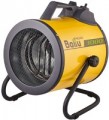Increase in air temperature (ΔT)
This parameter describes the difference between the air temperature at the inlet to the heater and the outlet temperature — in other words, by how many degrees the air temperature rises when passing through the unit. The higher ΔT, the hotter the outgoing air will be and the more attentively it is necessary to observe safety measures (do not place the device near flammable and heat-sensitive materials, prevent people from being in the immediate vicinity of the gun exit, etc.).
Rated current
The current consumed by the heat gun during normal operation. This parameter is useful primarily for assessing the load on the mains that occurs during the operation of the unit and organizing the appropriate connection. In particular, the rated current of the fuse installed in the connection circuit cannot be lower than the total rated current of the connected load — otherwise, the power will be turned off. Heat guns (primarily electric, see "Power supply") are quite high consumption consumers in terms of current.
Power consumption
The power consumed by the electrical components of the industrial heater during operation.
This parameter allows, first of all, to assess the load on the power grid and the suitability of the available power for the normal operation of the unit. It is relevant for all types of modern industrial heaters (see "Power supply"). However, it is worth noting that in some electric models, the power consumption is indicated for the ventilation mode. In this mode, the heating element is not activated, and the power consumption is extremely low — a few tens of watts. In such cases, the total power can be estimated from the maximum thermal output (see above) — in electrical models, these parameters practically do not differ from each other.
Airflow
The maximum amount of air that an industrial heater can pass through itself in a certain time.
This parameter is associated with an increase in air temperature (see above): at constant power, higher performance usually corresponds to a smaller temperature difference. Accordingly, a more efficient industrial heater will heat the entire volume of the room faster, but the heating temperature will be lower. So, it is worth choosing according to this parameter, taking into account what is more important for you — a large temperature difference or a high heating rate.
Power adjustment
The method of adjusting the heating power provided in the design of the heat gun.
- Stepped. Step adjustment assumes the presence of several fixed power values, between which switching is carried out during the tuning process. The accuracy of such a setting is worse than that of a stepless one (see below), even in cases where there are quite a lot of fixed values. At the same time, perfect accuracy is far from always required, and setting a specific value is easier than selecting the position of the regulator with stepless adjustment.
-
Stepless. Stepless systems include adjustment systems that do not have fixed steps and allow you to set the power value in any range from minimum to maximum. Due to this, this setting is extremely accurate, although in some cases it is not as convenient as the stepped one described above.
Max. operating time
The longest time during which the industrial heater can work without interruption.
The value of this parameter depends on the power supply (see above). So, in diesel models, the operating time is usually indicated on one full tank, without refuelling. Note that this implies operation at the lowest power, with minimal fuel consumption, and in optimal environmental conditions. Therefore, when choosing a diesel heat gun for this parameter, it is worth taking a certain margin, or better, separately calculating the operating time at the highest fuel consumption: for this, the volume of the tank (see above) must be divided by the maximum consumption. If we are talking about a gas or electric model, then the maximum operating time usually means the time during which the unit can work without overheating.
Regardless of the type, the long maximum run time provides additional convenience when working with an industrial heater. At the same time, it does not always make sense to pursue the maximum value of this parameter: in fact, the need for continuous heating for a long time occurs quite rarely. In addition, many diesel models allow refuelling right during operation (and in others, the refueling break usually does not exceed a few minutes). Therefore, it is worth specifically looking for a heat gun with a long time of continuous operation only if such a feature is fundamentally important to you.

